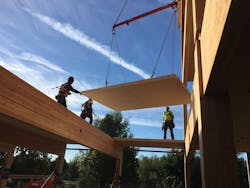Accommodating Mass Timber Buildings—the Right Way to Change the Building Code
It seems inevitable that change evokes anxiety. When new technologies or products appear, those who do not understand or are reluctant to use them often resist change by spreading unfounded rumors or horror stories about the potential consequences of their use.
Case in point: the emerging application of mass timber products for tall wood buildings. In some industries and public services, there is almost knee-jerk reaction to the perceived hazards of structural weakness and fire.
To address evolving mass timber technology, the International Code Council (ICC)—publishers of the predominantly used International Building and Fire codes—established its Ad Hoc Committee on Tall Wood Buildings (TWB) to study the science and engineering behind the materials and design before recommending including them in the latest editions of the codes. Their work, which was approved by the ICC membership in December, resulted in guidance to local code officials and first responders on the code-compliant construction and occupancy of these buildings
The TWB, which is currently proposing a few additional changes to the structural provisions of the building code, comprises designers, materials interests (including competing industries), code officials and members of the fire service, including firefighters, fire chiefs and fire protection engineers. The group researched and designed appropriate fire testing of mass timber materials and assemblies. Five full-scale fire tests were conducted to observe the performance of a two-level apartment-style structure constructed of mass timber. The tests were conducted at the federal Bureau of Firearms, Tobacco Alcohol and Explosives (ATF), following scenarios prescribed by the TWB. The tests were witnessed by a large and diverse group of people, and thousands of fire performance data points were collected for analysis.
Based upon test results, the TWB drafted code change proposals to ensure that tall wood buildings will have rigorous and redundant systems of fire protection suitable for the mission of protecting the public and fire responders. The work was distributed among four critically analytical teams—Height and Area, Fire, Standards and Definitions, and Structural, which took two years to deliberate on the data, assemblies and results before making its recommendations. In accordance with ICC rules, all meetings were announced and open to the public for observation and comment. All agendas, minutes and committee working documents were published online as soon as they were available.
The TWB submitted its proposals to multiple ICC hearing committees that are charged with analysis and review of all proposals to amend the model codes. Like the TWB, these standing committees include design, construction and fire safety experts. After deliberation and some modifications recommended by the TWB, these committees passed each proposed change over opponents’ testimony. Subsequently, public comment hearings were held where once again the opponents were provided the opportunity to present their concerns in an open forum. Nonetheless, the eligible government representatives present at the hearings voted to approve the favorable committee recommendations, advancing the proposals for one more final vote using the free online tool called cdpACCESS (an acronym for “Code Development Process Access” [www.cdpaccess.com]). In December 2018, ICC announced that its governmental members upheld the TWB proposed changes, which will appear in the 2021 edition of the ICC codes.
The TWB has demonstrated the right way to change the building code—after careful analysis of: current building codes; the results of numerous fire tests, including the ATF fire tests; and a performance-based approach to ensure that tall wood buildings provide similar performance compared to current construction types allowed by the code.
No one should let emotion drive their opinion of the proposed tall wood changes to the ICC; there is no need to fear the process or conclusions that have been reached, because the code is being changed in the right way.
While structural integrity and safety concerns are legitimate questions for the fire service to raise, there is a way to relieve one’s anxiety. Learn more about TWB science and engineering and get involved in the building and fire code development processes to learn about and contribute to the ultimate desired outcome—resilient and safe buildings. Unlike many countries, the United States remains one where regulatory safety codes are developed through a consensus process, and anyone with an interest in safety for the built environment can participate.
About the Author
Rob Neale
Rob Neale is the owner and principal consultant at Integra Code Consultants, a Maryland-based firm providing code consulting, plan review and training. He is the former vice president of National Fire Service Activities at the International Code Council and deputy superintendent for curriculum and instruction at the National Fire Academy.
